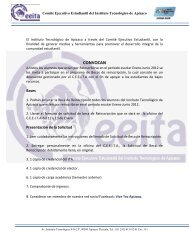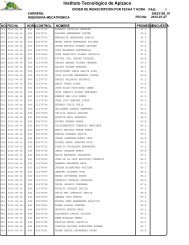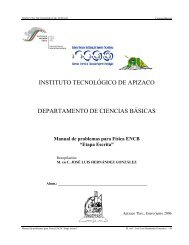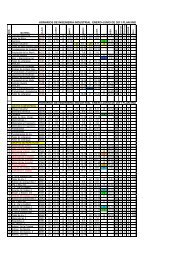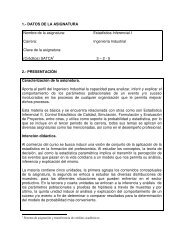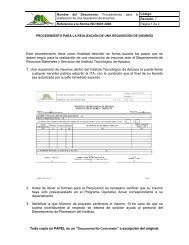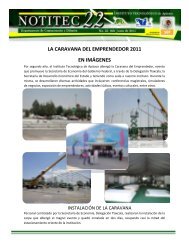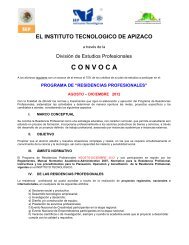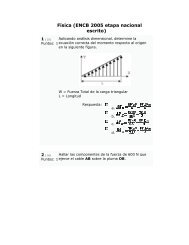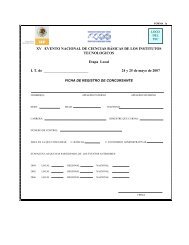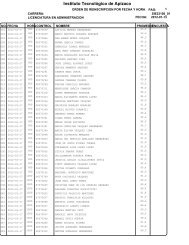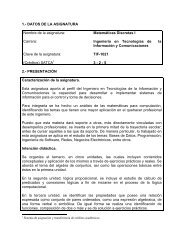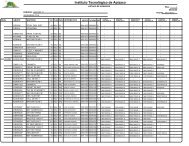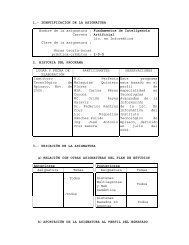Vibración Libre (Sistemas con un grado de libertad) Movimiento ...
Vibración Libre (Sistemas con un grado de libertad) Movimiento ...
Vibración Libre (Sistemas con un grado de libertad) Movimiento ...
Create successful ePaper yourself
Turn your PDF publications into a flip-book with our unique Google optimized e-Paper software.
INSTITUTO TECNOLÓGICO DE APIZACO Departamento <strong>de</strong> Ciencias Básicas<br />
<strong>Vibración</strong> <strong>Libre</strong> (<strong>Sistemas</strong> <strong>con</strong> <strong>un</strong> <strong>grado</strong> <strong>de</strong> <strong>libertad</strong>)<br />
<strong>Movimiento</strong> armónico<br />
Objetivo:<br />
El alumno comparará la solución al problema <strong>de</strong> vibración libre <strong>de</strong> forma analítica y<br />
experimenta por medio <strong>de</strong> <strong>un</strong> sistema <strong>de</strong> <strong>un</strong> <strong>grado</strong> <strong>de</strong> <strong>libertad</strong> <strong>con</strong>stituido por <strong>un</strong>a masa y <strong>un</strong><br />
resorte.<br />
Materiales:<br />
1 resorte<br />
1 plato <strong>de</strong> balanza<br />
Masa <strong>de</strong> peso <strong>con</strong>ocido<br />
Equipo:<br />
Calculadora<br />
CBR<br />
Activida<strong>de</strong>s:<br />
Se requiere <strong>de</strong>terminar el valor <strong>de</strong> la <strong>con</strong>stante elástica <strong>de</strong>l resorte; resolver la ecuación<br />
diferencial para <strong>un</strong> sistema <strong>de</strong> <strong>un</strong> <strong>grado</strong> <strong>de</strong> <strong>libertad</strong> <strong>con</strong>si<strong>de</strong>rando el valor <strong>de</strong>l coeficiente <strong>de</strong><br />
amortiguamiento como cero, comparará la solución analítica <strong>con</strong>tra la solución experimental.<br />
Determinar la relación entre las variables <strong>de</strong> forma:<br />
a) Verbal<br />
b) Tabular<br />
c) Grafica<br />
d) Analítica<br />
Un sistema <strong>de</strong> <strong>un</strong> <strong>grado</strong> <strong>de</strong> <strong>libertad</strong> esta dado por:<br />
x<br />
Don<strong>de</strong><br />
Fk<br />
Fc<br />
FI = ma; Fc = cv; Fk = kx<br />
k m<br />
F(t)<br />
FI + Fc + Fk = F(t)<br />
ma + cv + kx = 0<br />
mx’’ + cx’ + kx = 0<br />
<strong>Vibración</strong> <strong>Libre</strong> 1 M. en C. José Luis Hernán<strong>de</strong>z González<br />
FI<br />
Fk<br />
Fc<br />
F(t)
INSTITUTO TECNOLÓGICO DE APIZACO Departamento <strong>de</strong> Ciencias Básicas<br />
Formulación:<br />
Consi<strong>de</strong>re <strong>un</strong> sistema <strong>de</strong> <strong>un</strong> <strong>grado</strong> <strong>de</strong> <strong>libertad</strong> <strong>con</strong> <strong>un</strong>a masa y <strong>un</strong> resorte como se muestra,<br />
La ecuación que mo<strong>de</strong>la el fenómeno <strong>de</strong> vibración libre es:<br />
my’’ + cy’ + ky = 0<br />
Don<strong>de</strong> c = 0, entonces se <strong>con</strong>si<strong>de</strong>ra movimiento armónico<br />
Si <strong>con</strong>si<strong>de</strong>ramos que:<br />
w 2<br />
n =<br />
my’’+ ky = 0<br />
k<br />
m<br />
w n =<br />
y’’+ wny = 0<br />
Evaluando las <strong>con</strong>diciones iniciales<br />
y(0)<br />
y’(0)<br />
La solución está dada por:<br />
y'(<br />
0)<br />
y = sen(<br />
w n t)<br />
+ x(<br />
0)<br />
cos( w nt)<br />
(1)<br />
w n<br />
El período es:<br />
k<br />
T = 2π<br />
m<br />
y la frecuencia natural es.<br />
1 1 k<br />
f n = =<br />
T 2π<br />
m<br />
Suponga que la solución <strong>de</strong> la ecuación diferencial esta dada por<br />
C<br />
y0 D<br />
y = Acos(ωt + θ) + C<br />
A<br />
<strong>Vibración</strong> <strong>Libre</strong> 2 M. en C. José Luis Hernán<strong>de</strong>z González<br />
T<br />
k<br />
m<br />
m<br />
k<br />
y
INSTITUTO TECNOLÓGICO DE APIZACO Departamento <strong>de</strong> Ciencias Básicas<br />
Describa qué significa cada <strong>un</strong>a <strong>de</strong> las <strong>con</strong>stantes:<br />
A = _______ _______________________________________________________________<br />
C = _______ _______________________________________________________________<br />
D = _______ _______________________________________________________________<br />
T = _______ _______________________________________________________________<br />
y0 = _______ _______________________________________________________________<br />
Describa qué significan los siguientes parámetros:<br />
Frecuencia circular _____ _____________________________________________________<br />
Frecuencia natural _____ _____________________________________________________<br />
Período ______________ _____________________________________________________<br />
Ángulo <strong>de</strong> fase ________ _____________________________________________________<br />
Procedimiento:<br />
Colocar el resorte y suspen<strong>de</strong>r el plato, colocando el CBR a <strong>un</strong>a distancia mayor <strong>de</strong> 0.35 cm.<br />
(Tome en cuenta la <strong>de</strong>formación final <strong>de</strong>l resorte); <strong>de</strong>termine el valor <strong>de</strong> la <strong>con</strong>stante elástica y<br />
el valor <strong>de</strong> la masa.<br />
m =<br />
k =<br />
Ejecute el programa motiond() o ranger(), seleccione la sección a estudiar <strong>de</strong> los datos<br />
recopilados mediante el programa trimdata(), <strong>de</strong>termine los valores <strong>de</strong> cada <strong>un</strong>o <strong>de</strong> los<br />
parámetros:<br />
A = _______ _______________________________________________________________<br />
C = _______ _______________________________________________________________<br />
D = _______ _______________________________________________________________<br />
T = _______ _______________________________________________________________<br />
y0 = _______ _______________________________________________________________<br />
Escriba el mo<strong>de</strong>lo matemático <strong>de</strong>l movimiento analizado<br />
<strong>Vibración</strong> <strong>Libre</strong> 3 M. en C. José Luis Hernán<strong>de</strong>z González<br />
m<br />
k<br />
y
INSTITUTO TECNOLÓGICO DE APIZACO Departamento <strong>de</strong> Ciencias Básicas<br />
Calcule la velocidad y la aceleración <strong>de</strong>l objeto por medio <strong>de</strong> la <strong>de</strong>rivada. Sustituya los valores<br />
necesarios en la ecuación (1) y compare los valores teóricos vs experimentales<br />
Muestre sus gráficas:<br />
Ecuaciones Diferenciales Experimental (CBR)<br />
Compruebe que la solución propuesta sustituida en la ecuación diferencial <strong>de</strong>vuelve <strong>un</strong>a<br />
igualdad.<br />
<strong>Vibración</strong> <strong>Libre</strong> 4 M. en C. José Luis Hernán<strong>de</strong>z González



